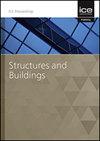Flexural behaviour of hollow reinforced concrete-filled fibreglass tubular beams
IF 1.4
4区 工程技术
Q3 CONSTRUCTION & BUILDING TECHNOLOGY
Proceedings of the Institution of Civil Engineers-Structures and Buildings
Pub Date : 2022-08-23
DOI:10.1680/jstbu.21.00128
引用次数: 0
Abstract
An experimental and numerical study of the hollow reinforced concrete-filled glass-fibre- reinforced-polymer tubular beams was carried out. Based on the bending tests, the working mechanism and failure modes were studied. A finite-element model was established and the validity was assessed by comparing the experimental and numerical results. The main parameters included the wall thickness of fibreglass tube, the reinforcement ratio, the hollow ratio, the concrete strength and the fibre winding angle. The results indicated that the composite beams failed gradually with considerable ductility. The bending capacity increased by about 12% with every 1 mm increment of the fibreglass tube thickness; increased about 40% as the reinforcement ratio increasing from 2.28% to 4.56%; and increased about 6% with every 5 MPa increment of the concrete strength. The bending capacity decreased and then increased as the fibre winding angles ranging from 10° to 90°, and small fibre winding angle was preferable for the flexural member. The hollow ratio of 0.375 is proved to be applicable to obtain lighter member self-weight with minimal strength decrease.空心钢筋混凝土填充玻璃纤维管梁的受弯性能
对玻璃纤维增强聚合物空心管梁进行了试验和数值研究。在弯曲试验的基础上,对其工作机理和破坏模式进行了研究。建立了有限元模型,并将实验结果与数值结果进行了对比,验证了模型的有效性。主要参数包括玻璃纤维管的壁厚、配筋率、空心率、混凝土强度和纤维缠绕角。结果表明,组合梁是逐渐失效的,但具有相当的延性。玻璃纤维管材厚度每增加1 mm,弯曲能力提高约12%;当配筋率由2.28%增加到4.56%时,增加了约40%;混凝土强度每增加5mpa,提高约6%。纤维缠绕角在10°~ 90°范围内,受弯构件的抗弯能力先减小后增大,且纤维缠绕角越小越好。结果表明,空心比为0.375时,构件自重较轻,强度损失最小。
本文章由计算机程序翻译,如有差异,请以英文原文为准。
求助全文
约1分钟内获得全文
求助全文
来源期刊
CiteScore
3.40
自引率
6.20%
发文量
61
审稿时长
12 months
期刊介绍:
Structures and Buildings publishes peer-reviewed papers on the design and construction of civil engineering structures and the applied research associated with such activities. Topics include the design, strength, durability and behaviour of structural components and systems.
Topics covered: energy conservation, people movement within and around buildings, strength and durability of steel and concrete structural components, and the behaviour of building and bridge components and systems

 求助内容:
求助内容: 应助结果提醒方式:
应助结果提醒方式:


